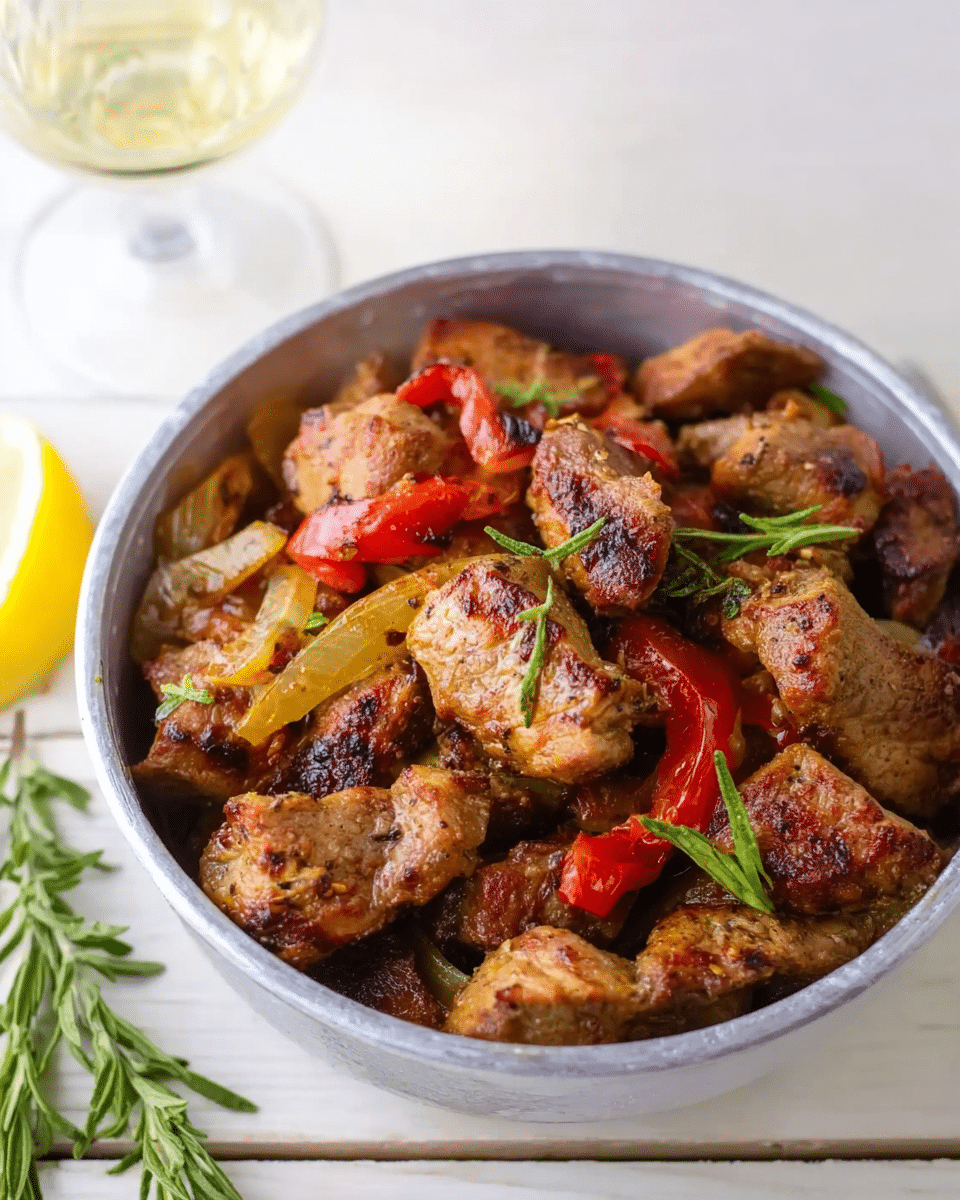The Origins and Traditions of Tigania
Tigania, or Greek pork chunks, has its roots in traditional Greek cooking, where simple yet flavorful ingredients are brought together to create dishes that are hearty and nourishing. The dish is a staple in Greek households and is often enjoyed as part of larger meals or festive gatherings. Tigania is often associated with comfort and home-cooked meals, reflecting the essence of Mediterranean cuisine, where fresh, seasonal ingredients are the star of every dish.
The dish’s origins can be traced back to Greek rural communities, where pork was a staple protein and often prepared in a variety of ways. The technique of shallow frying the meat with vegetables and then deglazing with white wine is a classic Mediterranean method that helps to elevate the flavors of the ingredients while keeping the dish simple and light. The use of lemon, an essential ingredient in Greek cuisine, adds brightness and freshness, perfectly complementing the richness of the pork.
Key Ingredients: The Heart of the Dish
The main ingredient in Tigania is, of course, the pork shoulder. Known for its tender, juicy meat, pork shoulder is a versatile cut that lends itself perfectly to slow cooking or shallow frying. In this dish, the pork is cut into bite-sized chunks and cooked to tenderness, allowing the flavors of the other ingredients to penetrate the meat. When cooking, it’s important to ensure that the pork is properly seasoned with salt and pepper to bring out its natural flavor.
Leeks and red peppers are the vegetables of choice in this dish. The leeks provide a delicate, slightly sweet flavor that pairs wonderfully with the savory pork. Red peppers add a pop of color and sweetness, enhancing the dish’s overall flavor profile. These vegetables are not only delicious but also help to create a beautiful contrast of textures, with the tender pork and caramelized veggies adding depth to every bite.
White wine is another key ingredient, used to deglaze the pan and infuse the dish with its acidity and depth. The wine helps to bring out the flavors of the pork and vegetables, making the sauce rich and flavorful. In Greek cuisine, wine is often used to complement and elevate the flavors of meat dishes, and Tigania is no exception.
Herbs such as oregano and thyme are traditionally used to season the dish. These aromatic herbs bring a touch of earthy flavor that ties the dish together, offering a balance to the richness of the pork. Lemon is an essential finishing touch, adding a refreshing acidity that cuts through the heaviness of the dish and brightens the overall flavor.
Cooking Method: A Perfect Balance of Technique and Flavor
The cooking method for Tigania is straightforward but requires patience to allow the flavors to develop. The pork is first placed in a cold skillet and covered with water. This method ensures that the pork is evenly cooked and allows it to release its juices, creating a flavorful base for the sauce. Once the water boils, the heat is reduced, and the pork is simmered, allowing the flavors to develop.
After about 30 minutes, when the water has evaporated, the leeks, red peppers, and lemon peel (optional) are added to the skillet. The vegetables are cooked until tender, and the pork begins to caramelize, adding a beautiful golden-brown color to the dish. The key to achieving this is allowing the pork and vegetables to cook undisturbed, which creates a nice sear that enhances the flavor.
The next step involves deglazing the pan with white wine. This is an essential part of the cooking process, as the wine helps to loosen any flavorful bits stuck to the bottom of the pan, which enhances the depth of the sauce. The wine is allowed to cook off, leaving behind its rich, slightly sweet flavor that infuses the pork and vegetables.
After the wine has reduced, the dish is seasoned with oregano, thyme, and lemon zest, creating a fragrant and flavorful sauce. The dish is then served with optional lemon wedges and a squeeze of fresh lemon juice to add a burst of brightness and acidity that balances the richness of the pork.
Serving Suggestions: How to Enjoy Tigania
Tigania is typically served with a variety of accompaniments, making it a versatile dish for any occasion. The tender pork and flavorful vegetables pair perfectly with traditional Greek sides such as a fresh Greek salad, roasted potatoes, or a side of rice. You could also serve Tigania with crusty bread, allowing guests to soak up the delicious sauce.
For a more Mediterranean-inspired meal, you might consider pairing Tigania with hummus, tzatziki, or even a side of tabbouleh for a light, refreshing contrast to the richness of the pork. If you’re looking for a heartier meal, you can serve Tigania with roasted vegetables or a side of couscous to make it more substantial.
This dish is also perfect for entertaining, as it can be made in large batches and served family-style. The flavors of Tigania only get better as they sit, making it an ideal dish for preparing ahead of time. It’s an excellent choice for a cozy dinner or a festive gathering with friends and family.
Health Considerations and Modifications
Tigania is a rich and flavorful dish, but it can be made lighter by using lean cuts of pork, such as pork tenderloin, instead of the fattier pork shoulder. Additionally, you can reduce the amount of oil used in the dish to cut back on fat. If you’re looking for a lower-carb option, serve Tigania with cauliflower rice or roasted vegetables instead of traditional sides like potatoes or rice.
For those following a gluten-free diet, this dish is naturally gluten-free as long as you use gluten-free wine and ensure that no wheat-based products are used in the preparation.
Conclusion
Greek Pork Chunks (Tigania) is a dish that brings the warmth and flavor of Greece to your table. With tender pork, caramelized vegetables, and the richness of white wine and herbs, Tigania is a delightful and satisfying meal that showcases the best of Mediterranean cooking. Whether you’re enjoying it on a casual weeknight or serving it at a family gathering, this dish is sure to impress with its bold flavors and simple preparation.

